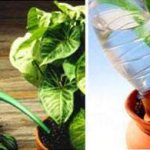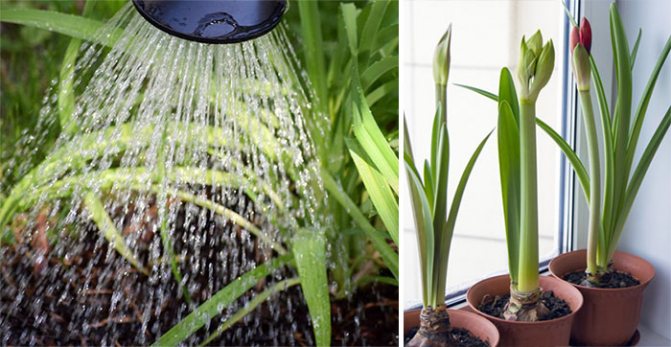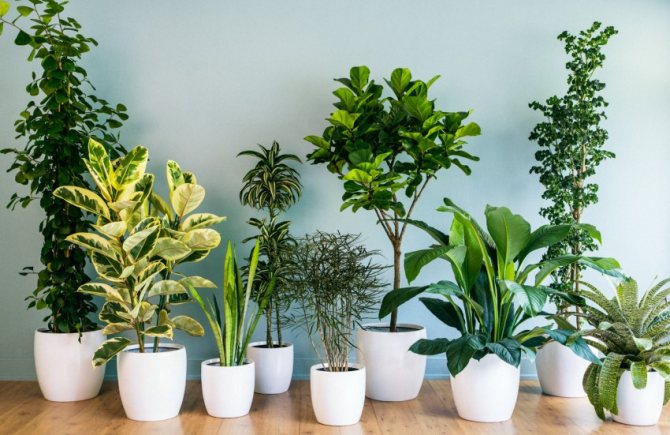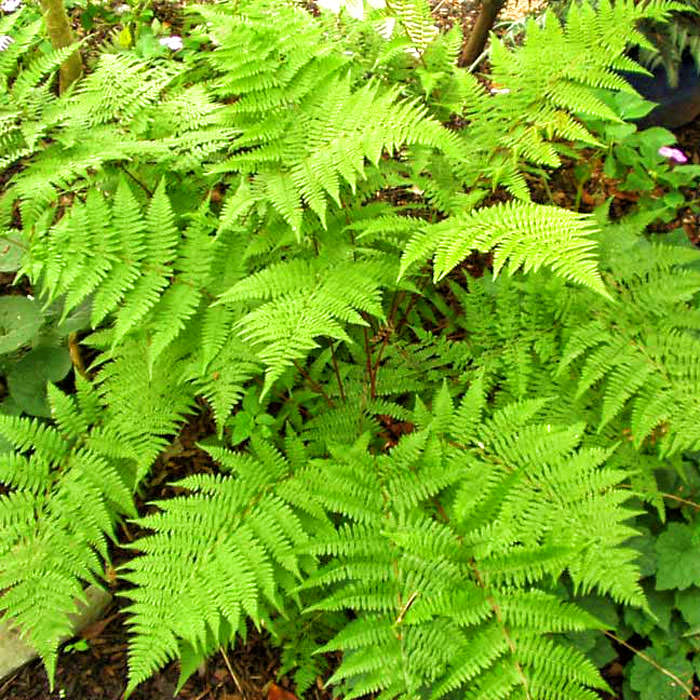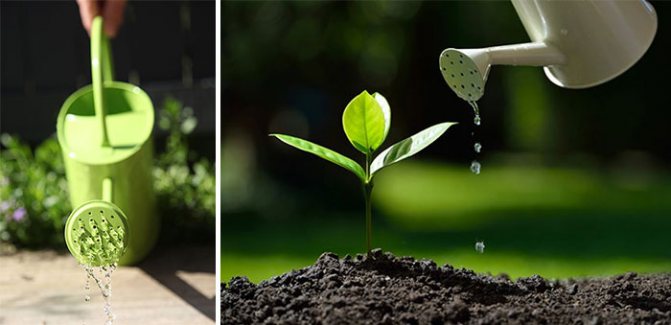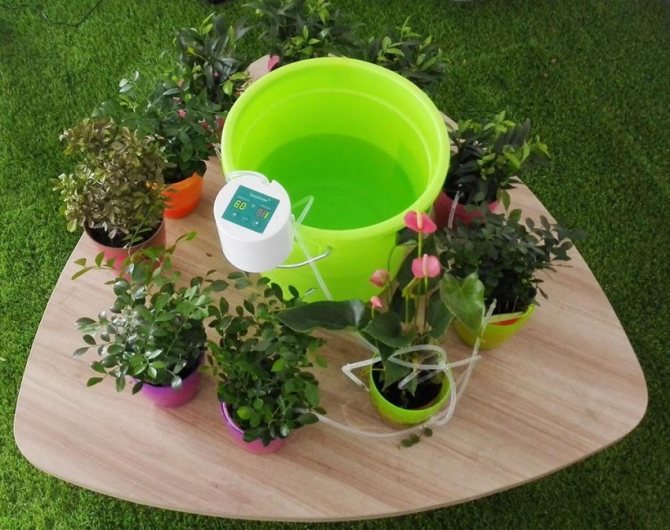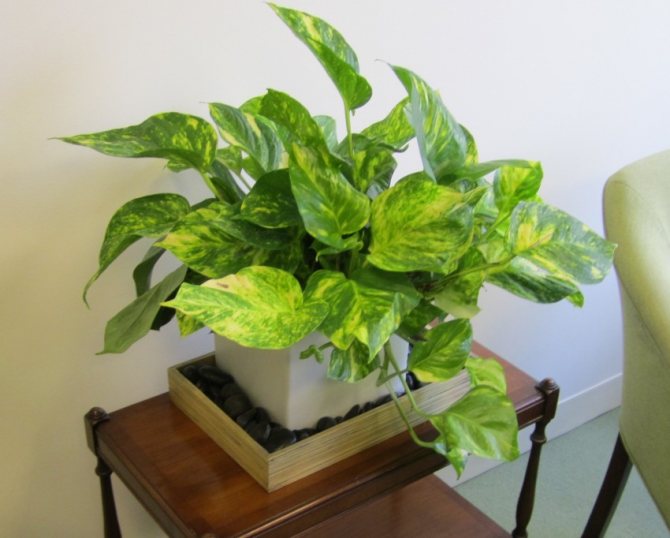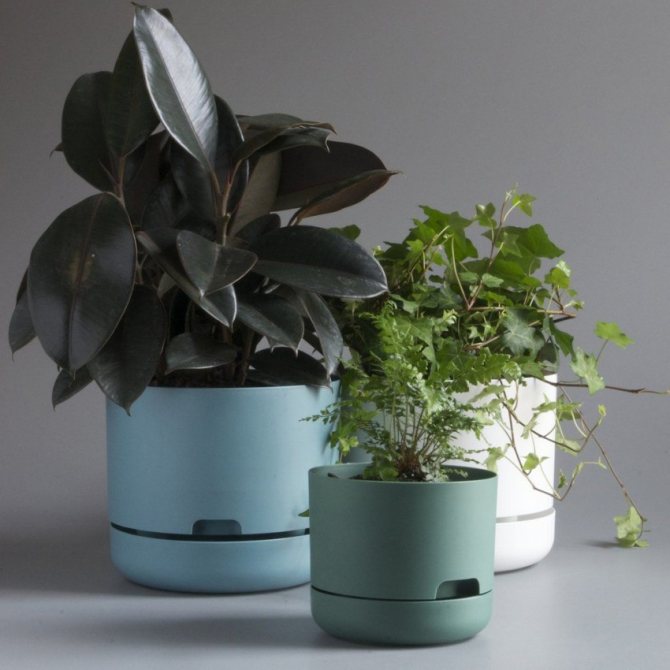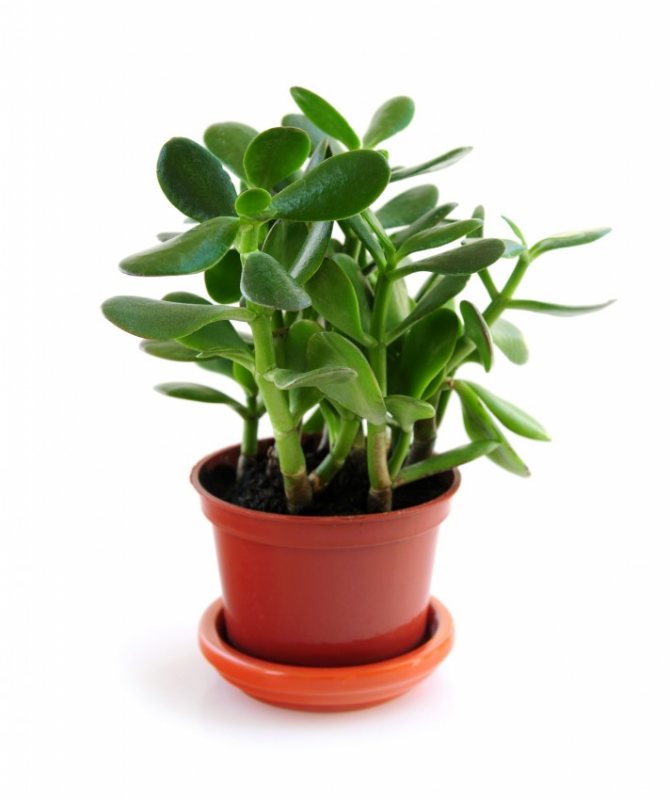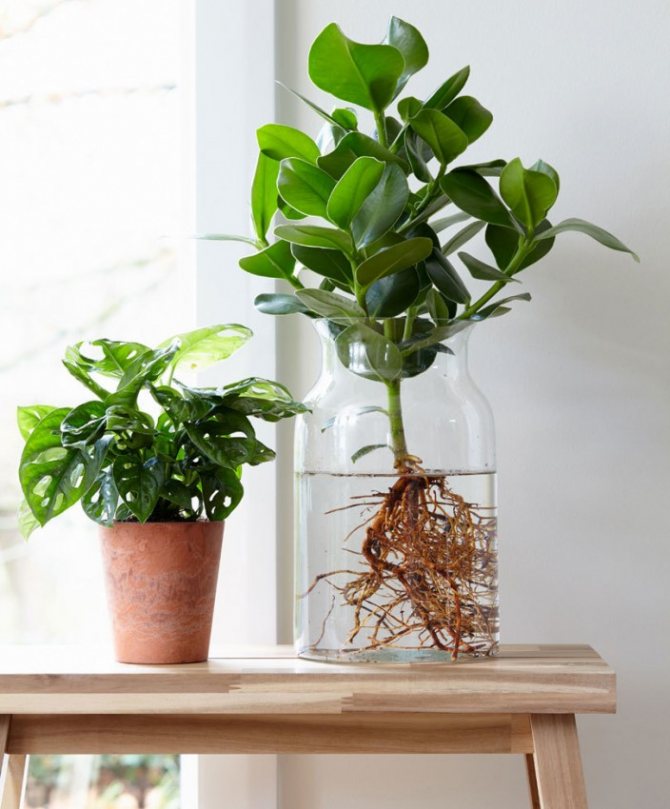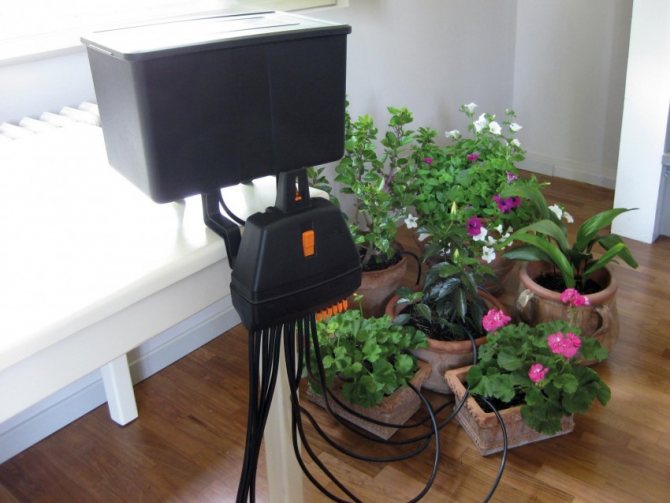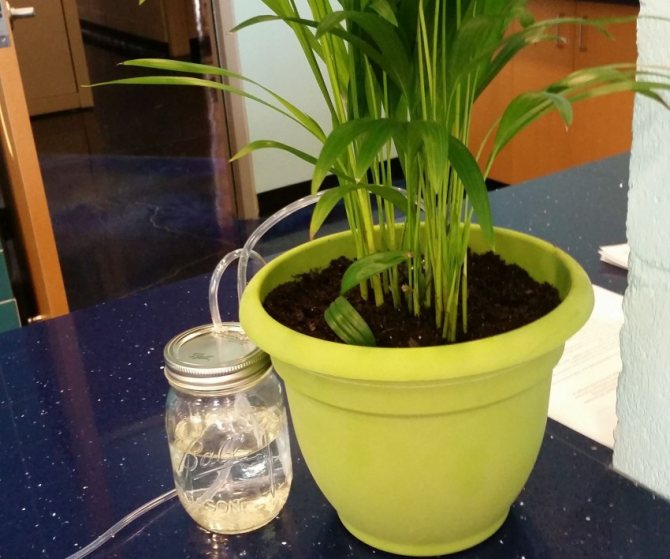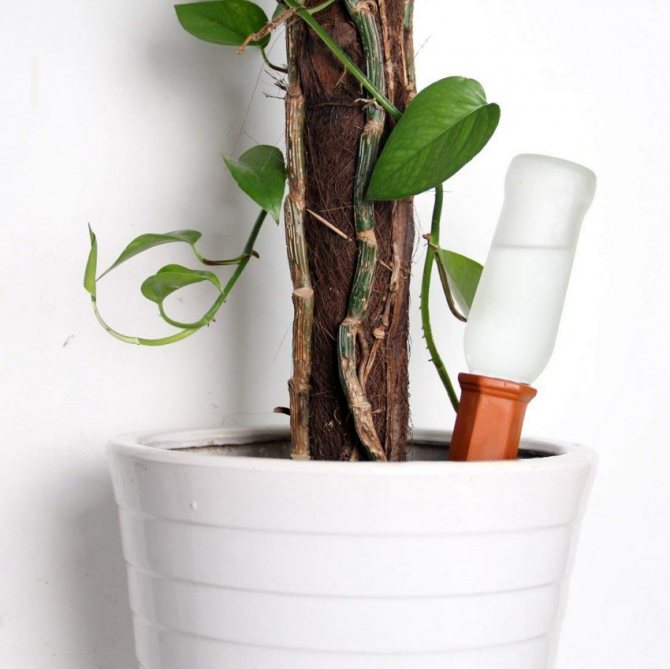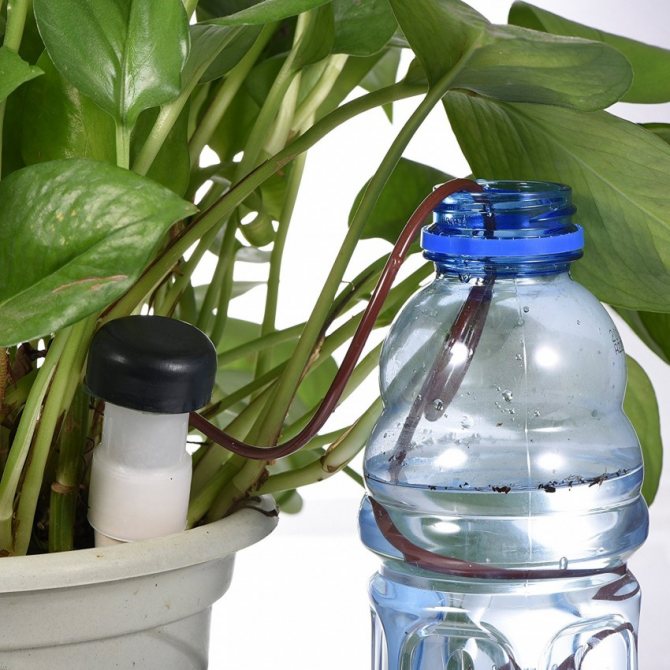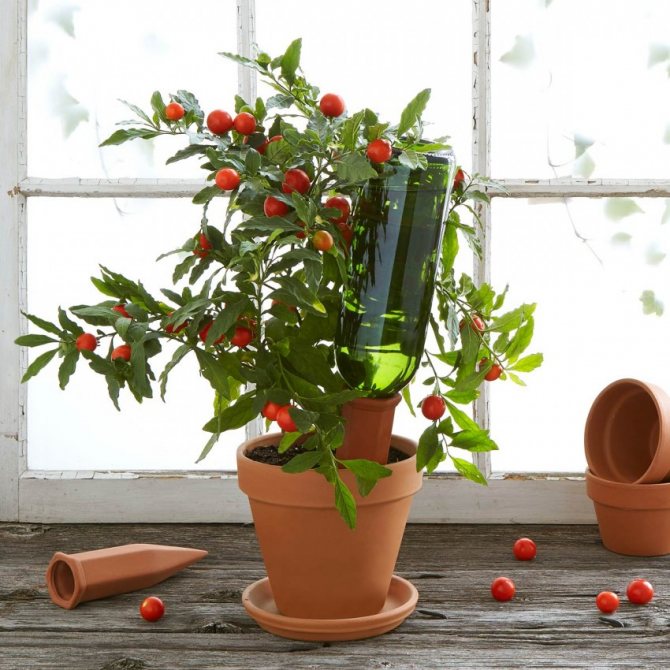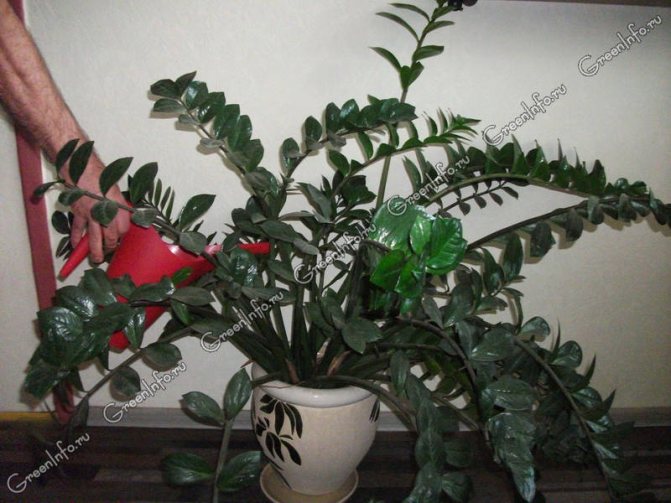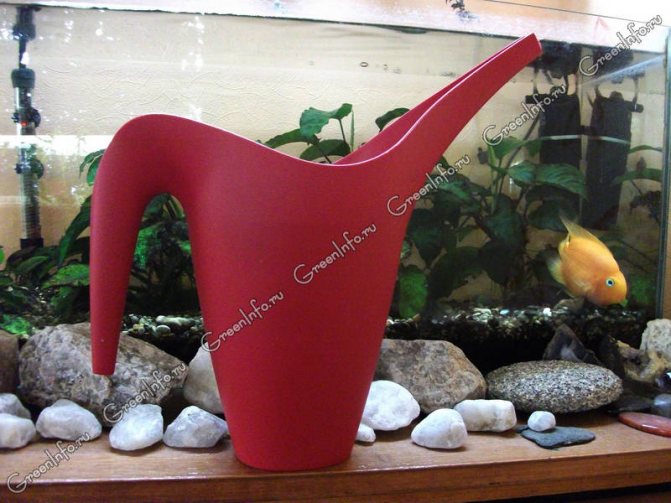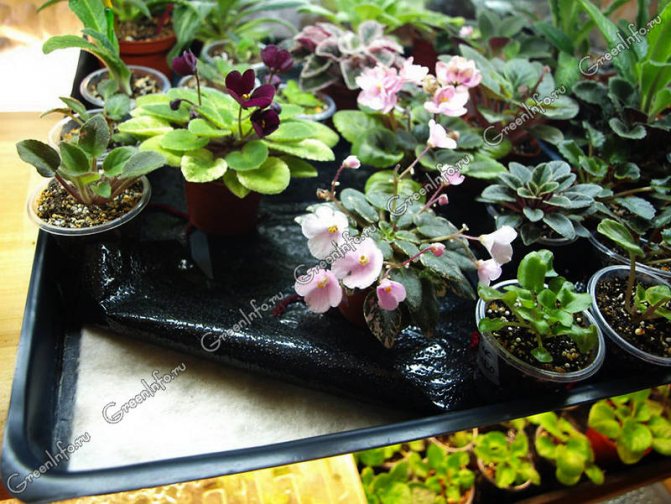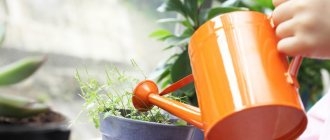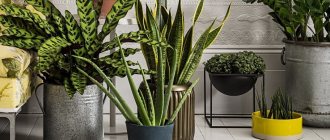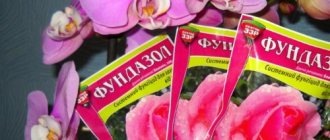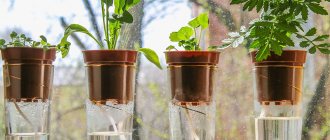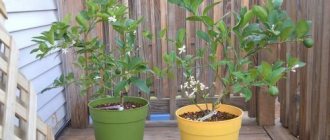Some houseplant lovers even check the lunar calendar to find the best watering dates. In this article, we will tell you how to properly organize watering indoor flowers at home... Useful tips, photo and video materials will be especially useful for novice growers who are just beginning to be interested in the rules of caring for indoor plants.
Below you will find practical tips to help you water most popular houseplants properly. We will cover issues such as choosing utensils for watering flowers, what water to water the flowers with, watering frequency, signs of a lack of moisture, watering methods, and how to water orchids and other indoor plants during your vacation.
♦ TABLEWARE FOR IRRIGATION OF ROOM FLOWERS:• a watering can with a long spout. A practical tool - a long nose can easily be directed through a dense crown, under the lower leaves or directly under the root rosette, so as not to drip water onto the delicate leaves of the flower. Very convenient equipment for watering plants in a phytowall or in phytomodules (vertical gardening);
• flask. A special device with an elongated tip and a spherical container for water. Such inventory can help out great when you need to leave for a long time. It is enough to fill the container with water and stick the nose of the flask into the soil, which will gradually become saturated with moisture as it dries;
• spray gun for spraying (sprayer). By spraying with water from a spray bottle, additional moisture can be supplied through the tops of the plant. This method will help you maintain the decorative qualities of the plant in the summer heat or during the heating season, when the humidity level in the room is very low;
• a pallet with water. A great way to additionally moisten the soil in the pot if the air in the room is too dry. It is advisable to put the flower pot not directly into the water, but on wet expanded clay or on pebbles in a pallet.

- in the photo: equipment for irrigation♦ WATER FOR IRRIGATION OF ROOM FLOWERS:► rain, river, pond water. Some flower growers prefer to water their indoor plants with melt and rainwater. Flowers respond well to watering with soft water from natural sources. But it is necessary to disinfect the water, add a few pieces of charcoal;
► tap water. Most of the inhabitants of megalopolises water their flowers with tap water. But it is important to remember that chlorinated tap water with slightly soluble calcium salts is very hard.It is imperative to defend this water for at least 24 hours (or better, several days) before watering the flowers, and pour out the remains from the very bottom. Water the plants with water at room temperature or lukewarm.
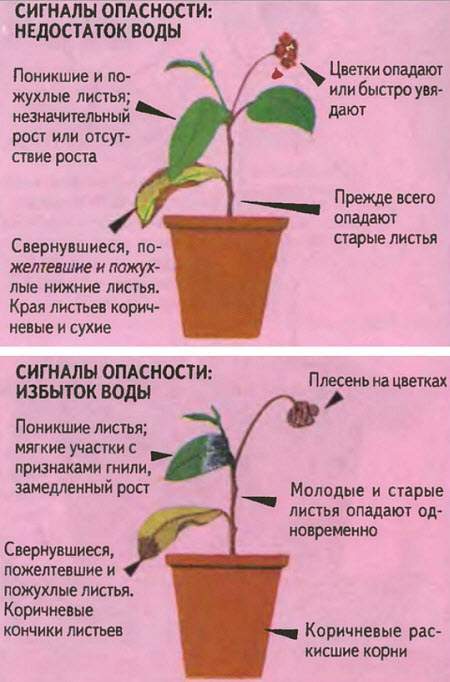

- in the photo: signs of a lack and an excess of water ♦ IRRIGATION FREQUENCY FOR ROOM FLOWERS:❂ the frequency of watering depends on various factors: the type of plant, the age and size of the plant, the microclimate in the room, the season (dormant or growing season), as well as the material from which the pot is made (ceramic, plastic, glass);
❂ Most houseplants like regular and even watering to keep the substrate in a moderately moist state. If the period of abundant soil moisture is abruptly replaced by a period of insufficient moisture, then the flower begins to wither and may die;
❂ in winter, many indoor plants slow down the growth and development processes (or stop altogether). The need for water with dissolved nutrients is significantly reduced and the plant needs to be watered much less often (or not watered at all). And in the spring-summer period, with an increase in the duration of sunlight and an increase in temperature, the frequency of watering increases up to 1-3 times a week;
❂ plants with large and wide leaves are watered more often (Benjamin's and rubbery ficus, Andre's anthurium, spathiphyllum, home begonia, gloxinia sinningia, jasmine gardenia, gerbera, balsam, shefflera, dieffenbachia). Bulbous species should be watered sparingly and less often, since waterlogging can lead to decay of the root system (hippeastrum, clivia, amaryllis, calla zantedeschia, oxalis oxalis, hyacinths, eucharis Amazon lily). Most types of potted orchids (phalaenopsis, dendrobium nobile) are watered no more than once a week in winter and no more than twice a week in summer. There are indoor species that can easily tolerate long breaks between watering (succulent species - bastard Money tree, aloe vera or agave, triangular spurge, Decembrist zygocactus, as well as species such as Blossfeld's Kalanchoe, chlorophytum, ‘mother-in-law’s tongue’ or sansevieria);
❂ ceramic (clay) pots have a good porous structure, circulation and evaporation of moisture is more active. But plastic pots retain water well in the substrate. Therefore, it is necessary to water a flower placed in a ceramic pot more often than in a plastic one.


- in the photo: rare, moderate and abundant watering♦ WAYS OF IRRIGATION OF INDOOR PLANTS:❀ top watering. To water the flower from above, it is advisable to use special dishes with a long spout (watering can, flask). It is advisable to direct the spout closer to the stem so that water does not fall on the leaves. If the plant has a developed leaf rosette, try to direct the stream of water under it so that the water does not stagnate. Water the plant evenly, in small portions, to avoid stagnant water on top of the soil. Pour out all the water that flows into the pan. This is a versatile way to water indoor species. The disadvantage of this method is that the useful substances and sludge of the substrate are quickly washed out. Therefore, do not forget to feed the plants in time.
❀ bottom watering. Some types of decorative deciduous plants lose their attractiveness if water drops fall on the leaves (yellowish or black spots appear, the leaf blade is deformed). Therefore, the tray is filled with water for irrigation. Within 30-40 minutes, the substrate is moistened to the top layer and all excess water from the pan must be drained. The disadvantage of this method is that mineral salts are not washed out, on the contrary, they stay in the soil for a long time. If a lime crust appears on the surface of the soil, then carefully remove it along with the top layer by adding fresh substrate.
❀ immersing the pot in water. A very good wetting method, allowing the soil to be completely saturated with water.Place the flower pot in a container of water so that water does not flow into the substrate through the edges of the pot. The water will quickly saturate all layers of the substrate through the drainage holes. Then place the pot on a wire rack so that any excess water can flow down freely. It is not advisable to use this method of moisturizing during the flowering period of the plant, when moving the pot can cause the buds and petals to fall off.


- tables with factors affecting the abundance and frequency of watering ♦ IRRIGATION OF INDOOR PLANTS DURING VACATION:√ vacation up to two weeks. - We moisten the soil abundantly by immersing each pot in water;
- rearrange all the plants from the window sills to the shelves of the shelves and to the floor stands for flowers, shade the window panes a little;
- it is advisable to thin out the leafy crown and cut the buds of flowering plants;
- pots with plants on shelves and on stands should be compactly arranged closer to each other (this will increase the level of moisture around the plants);
- immerse the pots in wide trays with wet expanded clay (so that the water level is a couple of centimeters below the upper layer of expanded clay). Wet sphagnum moss can be placed between the pots.
√ vacation up to three weeks.- complete all the steps described above;
- take plastic bottles of 0.5 l and make holes in the screw caps. After filling the bottles with water, set them in expanded clay between the pots, immersing them with tightly screwed caps with holes down. As the expanded clay dries, water will seep out of the bottle drop by drop;
- immerse a special flask for irrigation (see above) in each pot with a flower, with its nose down.
√ vacation up to one month.- there are special pallets for automatic irrigation on sale. The system consists of inner and outer trays, capillary mat. The outer pan is filled with water. The inner one is installed on top and covered with a capillary mat. This rug gradually absorbs moisture and gives it to the plants placed on it;
- instead of a flask for irrigation, it is best to install ceramic cones with thin hoses immersed in a container of water in each pot.
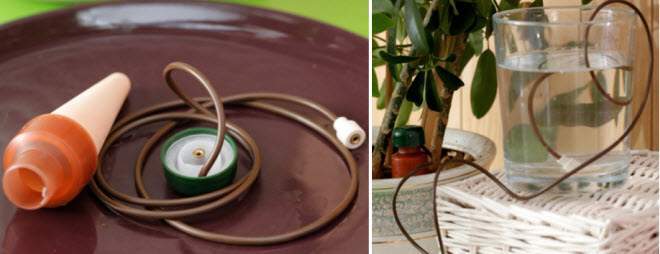

- in the photo: a ceramic cone with a hose for irrigation♦ HELPFUL TIPS FOR BEGINNING FLOWER GROWERS:☛ it is advisable to water rare and whimsical plants with settled mineral water (not carbonated) at room temperature;
☛ if the substrate in the pot, together with the earthen lump, is completely dry, then lower the pot into a container with warm, settled water to the edge of the pot and after ten minutes place it on the wire rack so that all excess water drains;
☛ after watering, be sure to drain all the water flowing into the pan so that the roots of the houseplant do not rot;
☛ sometimes (3-4 times) during the growing season it is useful to water the flower with warm, settled water (not salty!), In which the potatoes were boiled before. Starch helps to strengthen the root system and plant development;
☛ if during the flowering period the buds that have not yet opened began to actively fall off the plant, then there is a high probability that the soil is insufficiently or not regularly moistened (against the background of a low level of humidity in the room);
☛ Try to water the flowers so that drops do not remain on the surface of the stems and leaves. Water droplets dry out and leave unsightly stains and burns. Yellow spots and burns reduce the decorative value of the plant;
☛ Some indoor species require abundant watering during the growing season. These plants include many species with leathery leaves (Robusta ficus and De Dumbbell white, lemon tree, hoya wax ivy), as well as tropical varieties with bright and thin delicate leaves (petunia, calathea, arrowroot, croton);
☛ less often watering plants with small fleshy leaves that are dormant, in a cool room with high humidity, grown in plastic or glass dishes;
☛ if the tap water contains too much lime, then it is advisable to pass it through a special filter in order to use soft water for irrigation;
☛ never use cold water for irrigation, as this can lead to the gradual death of peripheral roots, the appearance of viral and fungal diseases;
☛ the most ideal time for watering most indoor species is early morning (with sunrise);
☛ On hot summer days and during heating, it is necessary to spray the plants with a spray bottle. A container of water can be placed next to the plants for additional humidification.
♦ HOW TO WATER ORCHID AT HOME:❶ Watering orchids can only be done with warm, settled soft water. It is advisable to water the rare collection and whimsical indoor orchid species with diluted distilled water. Stir the separated water of medium hardness with distilled water in a 1: 1 ratio. Stir too hard water with distilled water in a 1: 2 ratio;
❷ If the orchid is without bulbs, then water it after the substrate is completely dry, and the lower leaves begin to lose turgor and shrivel. If the orchid has bulbs, then water the flower after the bulbs begin to wrinkle a little;
❸ During flowering, most popular domestic varieties (phalaenopsis, dendrobium nobile) are watered very sparingly, 2-3 times a week. Make sure that water never stagnates in the pot around the roots and flows freely from the drainage holes;
❹ The best way to water an orchid in the summer is to soak the pot in warm, settled water for 10-15 minutes. Be sure to make sure that the water completely drains out of the holes in the bottom of the pot after soaking;
❺ how often to water the orchid at home. Complete drying of the soil is much safer for the root system than overflow. Most species can be watered at a frequency that is defined as: Once the substrate is completely dry, you can moderately water the flower the next morning. But do not forget that the frequency of watering also depends on the following factors: the type of orchid, the growing season or dormant period, humidity and temperature in the room, the composition of the soil, the pot (volume, what material it consists of).


♦ VIDEO:How to properly moisten the soil in a pot (for example, room begonia):
Watering indoor flowers while on vacation:
How to make a self-watering system for home plants with your own hands:
Another way to make drip irrigation from a plastic bottle:
How to water a phalaenopsis orchid:
Watering home types of orchids:
Helpful tips for beginners. How often to water an orchid at home:
Dear friends ! Please share your experience in caring for indoor plants in the Comments.
Different literatures give different ways to determine the water requirement of a plant. This is the tapping of a pot (a booming sound - dry), a difference in weight (wet ground is heavier), etc. But it is easy to make mistakes using such methods. You can more accurately determine the condition of the earth by immersing your finger in the ground. In general, over time, at fairly constant temperatures, watering is established in a certain mode, for example, every other day in the spring, every day - every other day in the summer, after two to three days in the fall, once every two weeks in the winter.
There are plants that are very sensitive to lack of moisture, such as azaleas, maidenhair. When the land dries up completely, azaleas die. There are also such plants (there are quite a few of them among indoor flowers) that do not tolerate overdrying or waterlogging.This is araucaria: when its twigs begin to droop from overdrying, then no amount of soldering helps. But overflow also leads to inevitable death. The same goes for gardenia, which is very much loved by flower growers.
In winter, during the dormant period, the growth of plants slows down or stops, at this time the plants need less water, and they are watered much less often, sometimes up to 1-3 times a month. In spring and summer, when the plant has a period of growth and flowering, on the contrary, watering is needed more often, sometimes up to 2-4 times a week. Autumn, especially rainy and cloudy, is a transitional period for plants. The growth of plants slows down, but does not stop, it is already cool in the apartment and on the balcony, the earth dries out much longer than on warm days in summer and the likelihood of overflow increases.
Watering every day
Watering in the autumn-winter period - from October to February
Perhaps none of the existing indoor plants needs such intensive watering during this period, except for azaleas, or indoor rhododendrons, and even then, if the air temperature in the room is +20 ° C. At higher temperatures, azaleas are unlikely to bloom.
Watering in the spring and summer - from March to September, provided that the room temperature is +24 ° C and above:
Almost all decorative leafy plants: dracaena, zamioculcas, codiaum, dieffenbachia, calathea, arrowroot, chlorophytum, ficus and others, flowering indoor plants, all types of ferns, plants with thin stems and leaves, as well as predatory plants such as nepentes, venus flytrap, darlingtonia Californian, Elwoodi cypress.
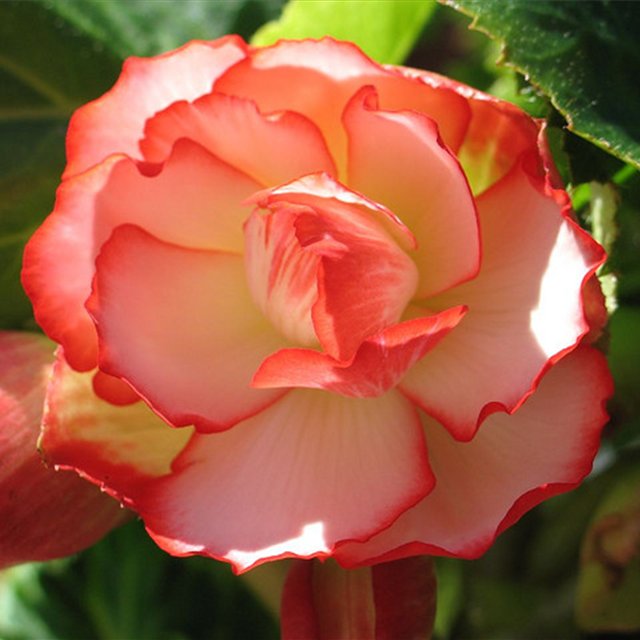

What water to water the plants?
Adding feed to the water
Currently, tap water contains a large amount of impurities.... Therefore, it can be dangerous. Rain or melt water is considered ideal. It is quite soft, from natural sources. For disinfection purposes, it is recommended to add a couple of pieces of charcoal to it.
Unfortunately, not all growers have the opportunity to water their pets in this way. Therefore, there is a simpler solution - to defend the tap water. At the same time, it must be defended for at least 12 hours. Better a few days. When watering, do not drain the water completely - a harmful sediment remains at the bottom, which is better to get rid of. This method has one more advantage - the water is heated to room temperature. For plants, especially tropical plants, this creates a more comfortable environment.
For faster use of tap water, you can filter it, or throw half a teaspoon of baking soda per liter of water.
Watering every 2 - 3 days
Watering in the autumn-winter period - from October to February, if the air temperature in the room is + 20 ° С and above:
Cineraria, tolmeya, dracaena, primrose, begonia, cyclamen, selaginella, nertera, paprika, fittonia, nightshade, dieffenbachia, Elwoodi cypress.
Watering in the spring and summer - from March to September, provided that the room temperature is + 24 ° C and above:
Cineraria, primrose, begonia, cyclamen, selaginella, ficus binnendica, fittonia, tolmeya, fuchsia, paprika, nightshade, all flowering indoor plants. The exceptions are orchids, cacti and bromeliads, succulents, cyperus papyrus, as well as indoor plants with velvety leaves and stems, such as Saintpaulia, Gloxinia.
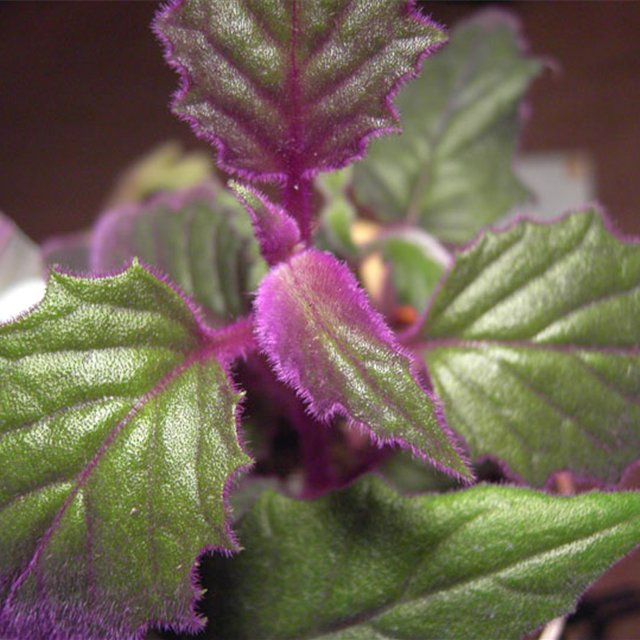

How to water flowers correctly?
The path to proper watering begins with planting bushes. Be sure to leave room for water in the pot.
Just a few centimeters from above, so that there is where to pour water, and not wait until the drops are absorbed and add more.
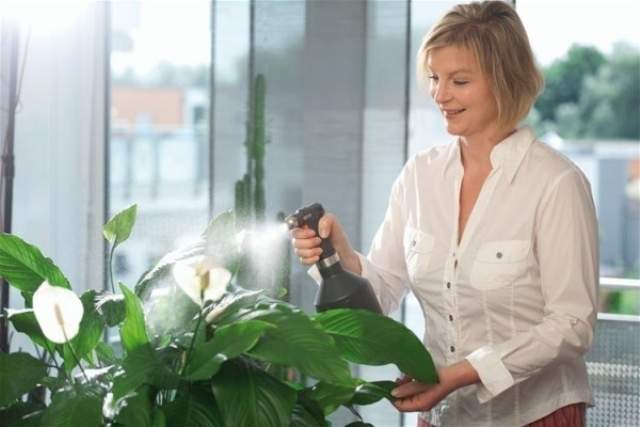

Spraying flowers in the apartment
Do not allow water to stagnate in the sump. This leads to root rot. After watering, wait 30-40 minutes, and then drain all excess water. It is better to use a watering can with a long spout.
By watering flowers with it, you will achieve maximum accuracy.Moisture will not get on the leaves and rosettes of flowers, which is undesirable to wet.
Water the plants in the morning.
Water evaporates more easily during the day. If you water the flowers at night, unnecessary dampness accumulates, which harms everything growing.
With excessively moist soil, the roots of flowers cease to "breathe". To restore oxygen access, dry the soil, do not water the flower for a while.
Depending on which pot contains the flower, we choose the appropriate watering method. There are three types:
- upper;
- lower;
- immersion.
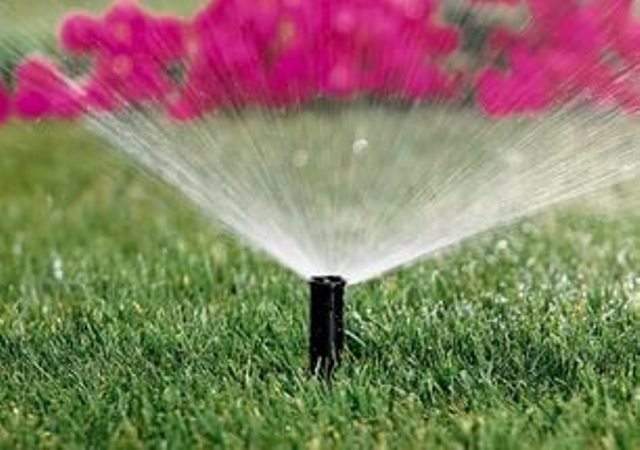

Automatic garden watering
Overhead watering is considered common. It is carried out in small portions on top of the pot. Thus, the entire substrate is moistened, the risk of water stagnation in the pot is minimized. Excess moisture is removed from the pallet. With this method of irrigation, part of the mineral salts is washed out of the soil. To compensate for losses, it is necessary to feed the plants regularly.
Bottom watering is performed in a pallet... Water rises through the drainage holes, feeding the roots, then evaporates from the soil surface. But with this method of watering, salts are not washed out of the substrate. On the contrary, they start to accumulate in excess. A lime crust forms on the surface, which must be removed as it carries a risk of contamination. This crust is removed and replaced with fresh soil.
Watering flowers by immersion which do not tolerate the ingress of water on the leaves. The flower pot is immersed in water and left to saturate with moisture for a few minutes. Then it is taken out on a horizontal surface, allowing excess moisture to drain. Cyclamens, violets, orchids, etc. are watered in this way. As a rule, such watering is done no more than once a week.
Plants with aerial roots are recommended to be watered by spraying the outer roots. Thus, epiphytes will receive both a sufficient amount of water and a lot of air.
Watering 1 - 2 times a week
Watering in the autumn-winter period - from October to February, if the air temperature in the room is from + 18 ° to + 20 ° С:
All flowering and decorative leafy plants, including calathea, arrowroot, poinsettia, orchid, almost all types of ferns, spathiphyllum, as well as predatory indoor plants.
Watering in the spring and summer - from March to September, if the air temperature in the room is from + 18 ° to + 20 ° С:
Indoor plants with herbaceous, soft and flexible stems: tradescantia, ginura, fittonia, pilea, peperomia, columnea, crossandra, dipladinia, medinilla, plants of the bromeliad family, indoor predatory plants.
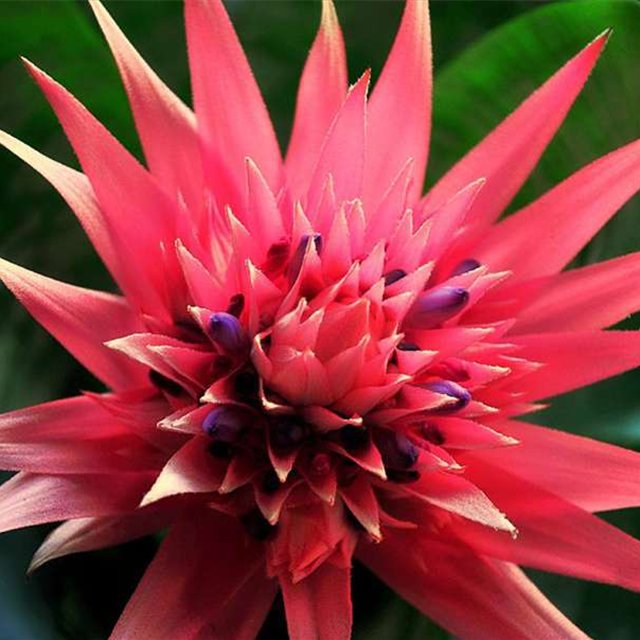

Factors affecting the abundance or frequency of watering
|
|
This is not to say that the cases shown in the comparative table are an unconditional rule. In fact, you need to take into account a number of factors to determine whether the water should be more or less. Violation of the irrigation regime, water quality, its temperature, will inevitably affect the plant. The more often this happens, the more severely the plant will suffer.For example, a particularly sensitive plant can immediately die from watering with cold water.
Watering once a week
Watering in the autumn-winter period - from October to February, if the air temperature in the room is + 15 ° to + 18 ° С:
Most of decorative leafy indoor plants and herbaceous plants with decorative flowers, plants of the bromeliad family, fuchsia, anthurium, banana, begonia with decorative leaves.
Watering in the spring and summer - from March to September, if the air temperature in the room does not exceed + 20 ° С:
Almost all decorative leafy houseplants, such as asparagus, decorative leafy begonia, pachistachis, cissus, akalifa, cymbidium, hibiscus, syngonium, ivy, alocasia.
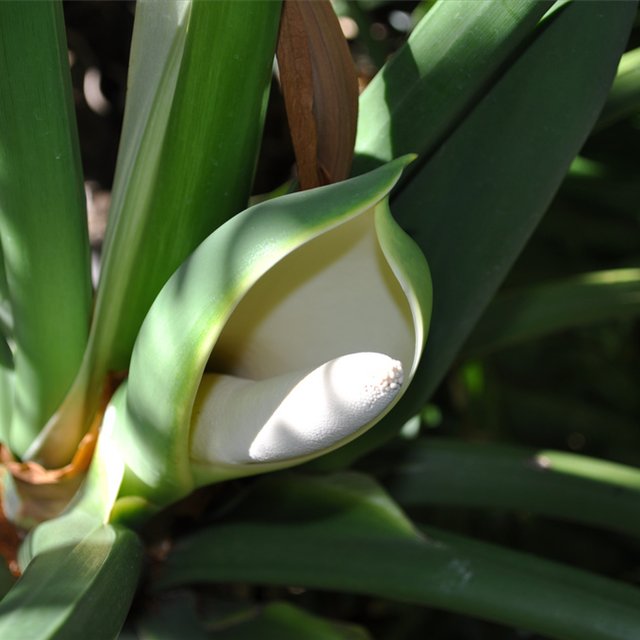

What to water from
For proper watering, it is advisable to get a watering can or a bucket with a fine-hole nozzle.
You can make a "watering can" for watering yourself from a plastic bottle, puncturing the holes in the lid with an awl. In general, you can water from a bottle without a lid, because the neck is narrow enough to control the jet size.


Some growers water plants from a glass, jug or other container with a spout.
Currently, modern technologists-inventors have come up with many mini-irrigation systems for an apartment or a small private house, smart and able to independently measure soil moisture and turn on the access of water to a pot for a plant that needs watering. Such a device will become a tangible assistant in the event that the owners leave or are often away on business trips.
Watering once every 7 - 10 days
Watering in the autumn-winter period - from October to February, if the air temperature in the room is from + 12 ° to + 15 ° С:
All Mediterranean and citrus plants, ivy, cissus, syngonium, chlorophytum, asparagus, poliscias, as well as faded poinsettia at rest.
Watering in the spring and summer- from March to September, if the ambient temperature is below + 20 ° С:
All types of palms, shefflera, ficus, philodendron, lotus, aspidistra, dieffenbachia, dracaena, cordilina, bokarnea, pakhira, yucca, kalanchoe, clivia.
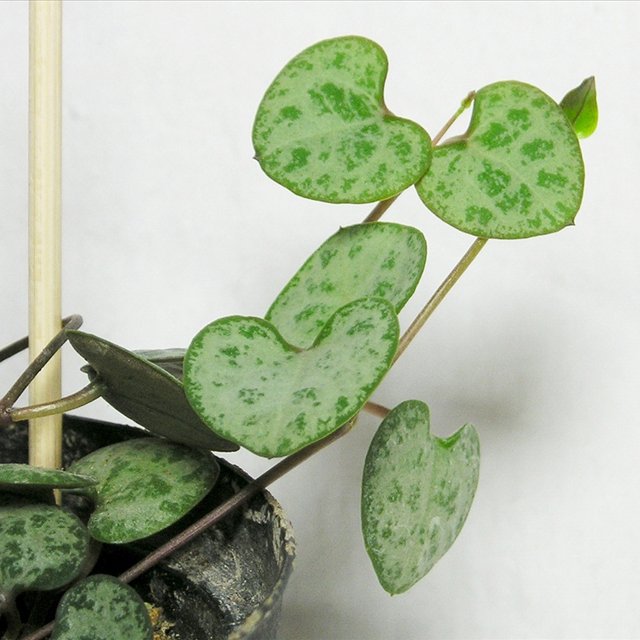

How to water indoor flowers so that they bloom
The florist's reward is the lush flowering of his plant. For this effort and time are spent, a number of rules of care and maintenance are observed, conditions are created.
Note: There are some species that rarely bloom. They discard buds only when they are mature. These include cactus and bamboo. Some cacti give flowers at 10-15 years of age, bamboo once every 80 or 100 years.
In order for the plant to bloom, you need to awaken the "survival instinct" in it. For this, uncomfortable conditions are created for them, since under the watchful attention of the grower, they are often in comfortable conditions and do not want to reproduce.
For the formation of buds, the difference between day and night temperatures is artificially arranged. In normal times, a temperature of 18-20 degrees is considered comfortable, but in such conditions the plant will only throw out the leaves. To increase the chance for a bud to appear, the night temperature is reduced by 15 degrees.
Watering once every 10 - 15 days
Watering in the autumn-winter period - from October to February, if the plant maintenance temperature is from + 8 ° to + 12 ° С:
All Mediterranean and citrus indoor plants, all types of palms, shefflera, ficus, philodendron, lotus, aspidistra, codiaum, dracaena, cordilina.
Watering in the spring and summer - from March to September, if the air temperature in the room does not exceed +22 ° С:
Almost all cacti, succulents, euphorbia, aloe agave, bastard, stonecrop, sansevieria, aeonium, ceropegia, echeveria, hoya, jatropha, pachypodium.
Which plants love moist soil and which ones love dry
In addition to external factors, the type of crops grown directly affects the frequency and intensity of irrigation. The gardener needs to know the features of plant maintenance, their need for water, and create the most comfortable conditions for their green pets.
Waterlogged soil is suitable for some plants, whose natural habitat in the wild is located in the immediate vicinity of a reservoir, in flooded and wetlands. These types include, for example, homemade papyrus - cyperus. In indoor conditions, the maintenance of such crops requires regular and excessive watering.
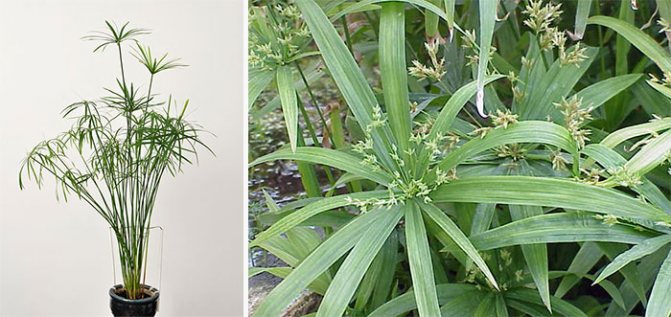

Wet soil is required by most ornamental indoor plants. The main requirement is to prevent stagnation of excess water in the soil so that there is no acidification and the appearance of rot. To do this, it is better to add liquid in small amounts, but more often. The irrigation regime should be varied from abundant to moderate, increasing the amount of water during the summer growing season and decreasing during the winter dormancy.
Dry soil is the natural habitat for most succulents. Of course, even desert plant species cannot do without life-giving moisture. But it must be borne in mind that these plants require rare watering with long breaks, during which the soil should almost completely dry out. In winter, cacti can do without water at all.
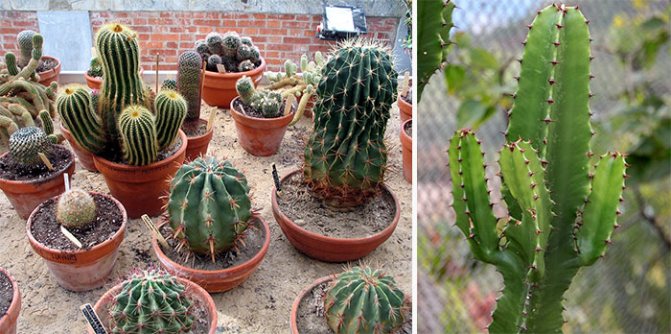

How to find out soil moisture
To maintain a comfortable moisture level in a pot with a plant, it is necessary to assess the condition of the soil from time to time. The most practical and effective way is to simply touch the ground. If the soil is loose enough, then you can immerse your finger in it and determine the liquid content not only in the upper layer, but also in the depths of the flower pot.
If the soil is too hard or you don't want to get your hands dirty, you can use a knitting needle or a wooden stick from Chinese food to take a sample. The current demand for water is determined by the remains of the substrate on the instrument. Care should be taken in the process so as not to damage the plant's root system.
[!] Before watering the plant, you always need to check the condition of the soil, perhaps there is already more than enough liquid in the pot at the moment.
Usually, an apartment has its own stable microclimate, and approximately the same amount of liquid is required to maintain the required soil moisture. Corrections have to be made during the transitional period of the off-season, especially in autumn. At this time, most plants prepare for dormancy, metabolic processes slow down, and fluid intake is noticeably reduced. In addition, due to rainy and damp weather, the air humidity remains high. In contrast to the hot summer, the soil in the pot practically does not dry out. If you do not take into account the changed conditions and maintain the previous irrigation regime, then you can overmoisten the soil and destroy the flowers.
The consequences of an incorrect watering regime
People who are not familiar with the cultivation of ornamental plants are of the opinion that the more watering the flowers, the better. Of course it is not. Excessive watering leads to the same sad consequences as the complete drying out of the soil, namely, the death of the plant.
Keep a close eye on your green friends, they will try to warn you about improper care.
External signs of a violation of the irrigation regime:
- The lack of fluid primarily affects the condition of the soil. The soil in the pot becomes dry, and when touched it easily crumbles and becomes dusty. The leaves and petals of the inflorescences of the plant wither, dry up and begin to fall off.
- Excessive watering manifests itself on the soil in the form of a fungal infection. Pathogenic microorganisms love to multiply in stagnant liquid. Moreover, mold, usually in the form of a gray fluffy bloom, can even spread to the stem and lower branches of the plant. Leaves wilt, rotting brown patches appear on them, and then fall off.
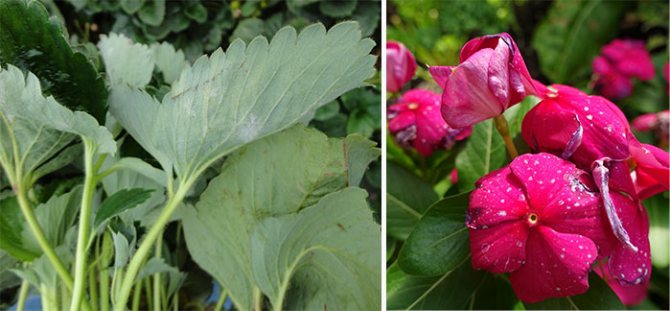

However, such external manifestations of plant malaise, as foliage dumping, are not always a mistake of watering. Before changing the regime, all other possible causes must be ruled out, such as illness, lack of light, or natural seasonal changes.
A dying plant can be simply watered, but it will be more difficult to save a flower rotting in waterlogged soil. To begin with, the plant must be carefully removed from the bowl together with the soil. All affected by the fungus and rotting areas of roots and soil should be ruthlessly removed, and the wounds should be sprinkled with charcoal for prevention.
Next, you need to get rid of excess fluid. For this, the root, together with the remnants of the soil, is wrapped in a material that absorbs moisture well. As an absorbent, you can use a cloth, baby diaper, toilet paper, or table napkins. You can plant a plant in a clean pot with fresh substrate only after the root is dry. For preventive protection against fungal infection, the flower should be treated with fungicides.
Water quality and composition for irrigation
Traditionally, the most suitable drink for green pets is clear rainwater or melted snow. There is a reason for this: in natural conditions, precipitation is the natural nutrition of all plant species. But it is necessary to take into account the realities of modern ecology and not to collect snow along the roadsides, and rainwater near chemical enterprises. However, in practice, most urban growers use ordinary tap water, but with additional treatment.
The easiest way is to pass the liquid through an ordinary household filter. The procedure will soften water and neutralize harmful substances. If this is not possible, you need to let the liquid settle for at least a couple of days. During this time, some of the harmful impurities will precipitate or evaporate. In addition, it will be useful to additionally soften the settled tap water by adding peat or wood ash at the rate of a tablespoon per liter of liquid.
It is especially important to monitor the temperature of the water for irrigation. Cold liquid can severely damage plant health: it can cause wilting, foliage and root rot. The water should be at least room temperature, and even better if it is a few degrees warmer. To do this, it is convenient to store watering containers near the battery in winter, and on a windowsill warmed up by the sun in summer.
[!] In some cases, for example, when growing for distillation, when it is necessary to accelerate metabolic processes and stimulate the vegetation of the plant, watering with practically hot water reaching a temperature of 50 ° C is practiced.
In order for green pets to develop well, bloom and delight the eye, it will be useful to add special complex fertilizers and growth stimulants to the water for irrigation. The main thing is to strictly observe the permissible norms recommended by the manufacturer. In addition to ready-made store dressings, potassium permanganate and iodine can sometimes be added to the water to disinfect the soil and plant roots.
Watering once every 15 - 20 days
Such rare watering can only be in the autumn-winter period - from October to February, provided that the temperature of the content is not higher than +12 ° C in such indoor plants as:
All cacti, succulents, indoor bulbous plants during vegetative dormancy, bokarnea, zamioculcas, sansevieria, pelargonium, fuchsia.
The only exceptions are bulbs, corms, tubers of already faded plants in a state of vegetative dormancy, they are not watered at all.
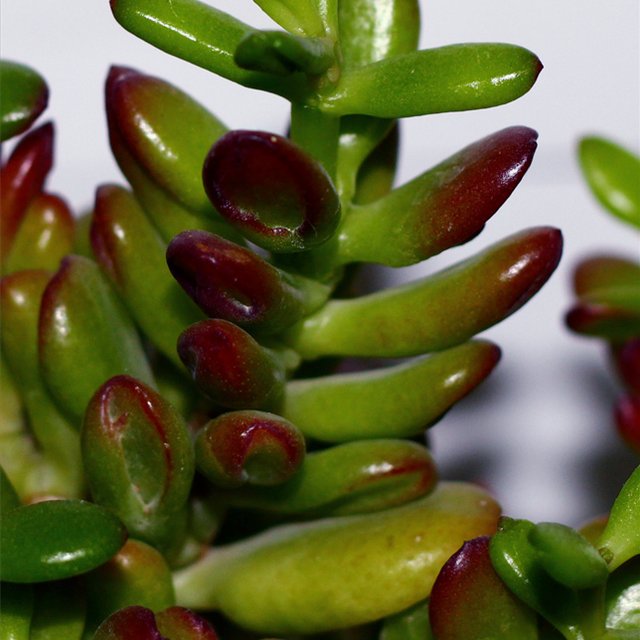

How often should indoor flowers be watered?
The frequency and intensity of watering primarily depends on the type of plant. In this regard, there are three main groups.


Watering flowers in the garden
- Plants requiring abundant watering. As a rule, these are tropical flowers, as well as plants with wide leaves. Moisture evaporates quickly from their surface.These are ficuses, begonias, oleander, passionflower, citrus fruits, etc.
- Requiring moderate watering. Due to their structure, they have the ability to store moisture. This is evidenced by thick stems, powerful roots, fleshy leaves. These are bulbous, aroid, arrowroot, palms, etc.
- Drought tolerant. They can go without water for several weeks. Basically, these are cacti, succulents.
Depending on the need for moisture in flowers, there are three types of watering:
- Abundant... The topsoil should dry out before watering. Flowers are watered on top with plenty of water, then the excess is drained from the pan. Carried out every day.
- Moderate... The soil before watering should be dry 13-15 mm from the top. Water until the entire soil is moistened, avoiding overflow. This watering occurs twice a week.
- Limited. The substrate should dry 60 percent. This can be tested with a wooden stick. Water from above, not allowing water to drain into the pan. It is recommended to produce no more than once every two weeks.
Watering frequency also depends on external conditions - humidity, temperature, season.
You also need to pay attention to the pot that contains the plant. In ceramic pots, the substrate dries out faster than in plastic pots. This means that you should water more often.
Excessive or insufficient watering of indoor plants
It often happens that the plant receives too little or too much water. Before watering your house flowers, find out what happens if you over-or under-water.
Insufficient watering. If the plant leaves or flowers fall off, the edges of the leaf blades become brown, and the leaves themselves look dull, then all these symptoms are signs of a lack of water. Rare watering of house flowers usually occurs during the owners' vacation. If you returned quickly and managed to react in time, then the plant can still be saved. The plant can dry out even when it is watered regularly, but it is always not enough. In this case, the earthen lump shrinks, a void arises between it and the walls of the pot, through which water flows down, without even wetting the earth.
What to do? First, gently loosen the top layer with a fork and press the soil with your hands to the edges of the pot. Then bathe: immerse the pot to the brim in a bucket of water and keep there until no more air bubbles rise. At the same time spray the aerial part of the plant with water dust. After that, the plant is placed in a cool place. Empty the sump from the water in half an hour!
Excessive watering. The first sign of excess water is the moss that covers the ground.
What to do? In such cases, it is often enough not to water the plant for several days and dry it slightly.
What to do in serious situations? It becomes difficult when spots appear on the leaves, the earth is wet through and through and smells sour - the roots are already rotting. In this case, you can try the following treatment:
- Spread a lot of newspapers in a shady place in the apartment;
- Remove the plant from the pot and put it on newspapers to dry;
- Only a few days later, after the earth dries up somewhat, transplant it into a pot again;
- If at the same time you find brown root tips, they should be cut off.
For indoor plants everywhere you can buy very beautiful second pots made of ceramic or plastic, variegated and monochromatic, sometimes with attractive patterns. They often enhance the impression of flowers. But more than one fan of second pots has caused a lot of harm to their pets.
The second pots, no matter what, have one big drawback: they often accumulate water imperceptibly. As a result, the inner pot is half in the water, which causes stagnant waterlogging, which is unacceptable for the plant, since the roots rot, and soon the flower can be thrown away.
Check for water between the pots some time after watering. Place a layer of pebbles on the bottom of the outer vessel, on which place the pot.
Watering tools
You can pour your favorite flower from a jar with tap water, but only once! If a plant has appeared at home, you should take this event responsibly. The costs will be small and the benefits huge. You will need things that are sold in stores:
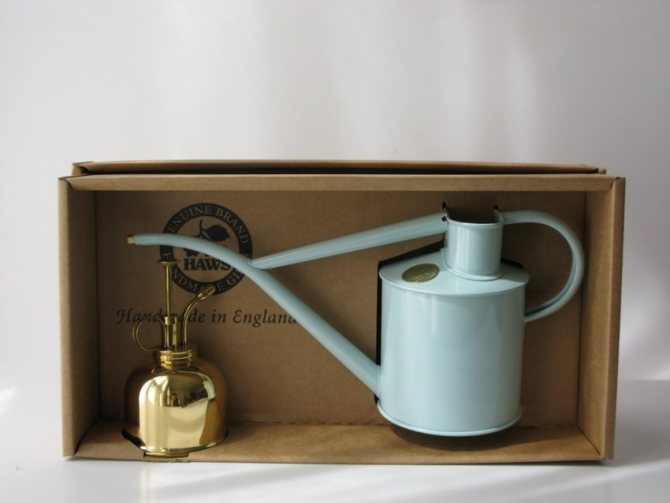

Watering can with a volume of 0.3-0.5 liters with a removable diffuser. With such a watering can you can shower or water the soil exactly at the roots, as required by certain types of plants.
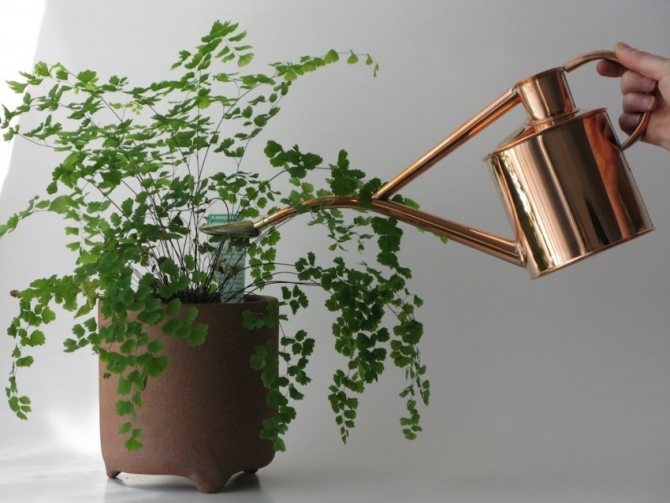

Tank for settling and storing water. Fertilizers are diluted in it, if necessary, before watering.


A spray bottle, with its help, the leaves of plants are sprayed. Hot batteries dry up the room air during the heating season, the leaves turn yellow and fall off without moisture.
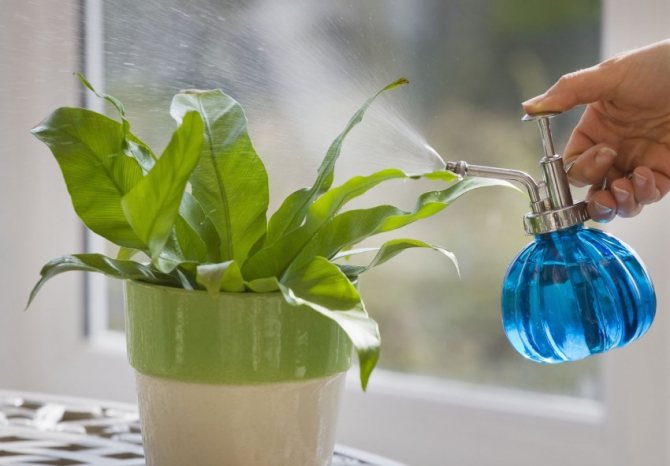

7.Basic rules of watering
- Watering should be carried out in the morning, so that water droplets falling on leaves and shoots evaporate before dusk and do not cause rot. An exception can be made only in summer - on hot days.
- Plants that are in direct sunlight should not be watered. The droplets of moisture, acting like a magnifying glass, concentrate the effects of the sun and the leaf blades get burned.
- The excess moisture that appears in the pan after watering is drained after a few minutes.
- If the soil has moved away from the walls of the pot, spread it over the entire volume of the pot before watering, otherwise the water will quickly go down the walls into the pan without saturating the soil.
- To soften the water for irrigation, you can add a little wood ash or soak a gauze bag filled with peat in it. After three such procedures, peat should be replaced with fresh peat.
- Lemon juice or a few citric acid crystals can be added to adjust the pH and soften the water.
- Always water flowers with water at room temperature: cold water - "shock" for the roots
- Watering should always be abundant - until the earthen coma is completely soaked. Remember that the root system draws moisture from the soil with its lower absorbent small roots and with poor watering, water may simply not reach them. An exception to this rule is bulbous and tuberous plants with a dormant period. Watering them abundantly immediately after planting will cause the bulbs and tubers to rot in large quantities.
- The need for watering can be judged by the turgor of plant leaves - leaf blades should be elastic, without visible wrinkles.
- After transplanting succulents and cacti, watering is usually stopped for 7 to 10 days - this allows the plants to adapt to the new soil, and the damaged roots will not rot.
- During watering, the spout of the watering can should be as close to the surface of the soil as possible so that the water will not wash it away.
- Drying of the soil between waterings is necessary, since the constantly swampy soil does not allow air to pass to the roots of the plants - as a result, the root system rots and the flowers die.
- Drainage must be present as the bottom layer of the soil, and the planting pot must have fairly large holes in the bottom for excess water to drain.
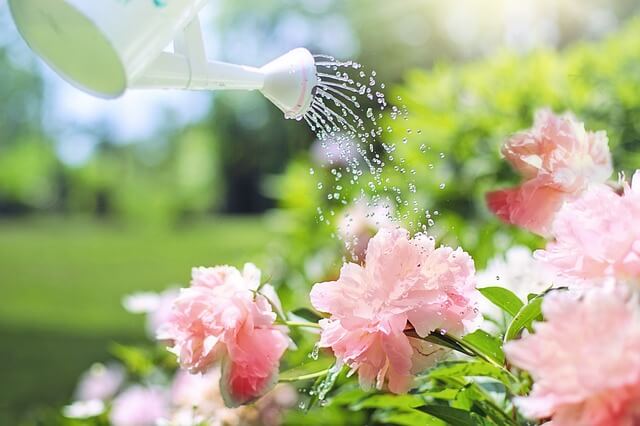

Watering indoor plants in the absence of owners: how to water house flowers while on vacation
If you need to leave, and there is no such neighbor who can sometimes water the flowers, then you need to provide self-service of the plants. This is possible, at least for some time.
Watering indoor plants in the absence of owners can be carried out using homemade water supply systems. The following methods have worked well and are not expensive:
- Thick threads: Arrange flower pots around a bucket or large pot of water. Take long lamp wicks or cotton strings and stick one end into the ground of the pots.The other end is lowered into the bucket. If the threads are wetted beforehand, the water flow will improve.
- Greenhouse from a package for plantswho need high air humidity. A greenhouse from the package will serve as an excellent option for moisturizing flowers during your holidays.
Specialist stores offer a range of different systems for watering home flowers while on holiday. In any case, you should first check for how long the supply of water is sufficient.
The wet canvas is used to provide water to a large number of plants. The canvas can be placed on the surface next to the kitchen sink with one end submerged in the water. Plants placed on a damp canvas can absorb moisture from it. The pots for this must be earthenware.
A clay cone for watering indoor flowers while on holiday can be recommended for single pots. It is filled with water and connected with a hose to the reservoir.
Plants that are left alone should be rearranged in the shade. Before leaving, you need to remove not only all wilted and faded, but also all unopened buds.
If you want to save yourself watering problems like a lot or a little, today or tomorrow, then you can transplant all the plants into pots with an automatic water supply. They are double bottom containers where the water tank is located. Through a wick or similar device, the plant itself takes exactly as much water as it needs. Naturally, such a device only works as long as you do not forget to replenish the water supply. This must be done every 14 days. But for a short vacation, your plant is provided with water.
The last section of the article is devoted to how to wash indoor plants.
What determines the moisture requirement of a plant: indicators of soil moisture
Flower shops offer various soil moisture meters for indoor plants. The main advantage of such indicators is that, thanks to special sensors, they demonstrate not only the level of water in the entire pot, but also its amount specifically at the roots of the plant. Such measurements are especially important for whimsical, demanding plants in care, for which the liquid level must always be at a certain level: you can neither overdo it, nor overdry it.
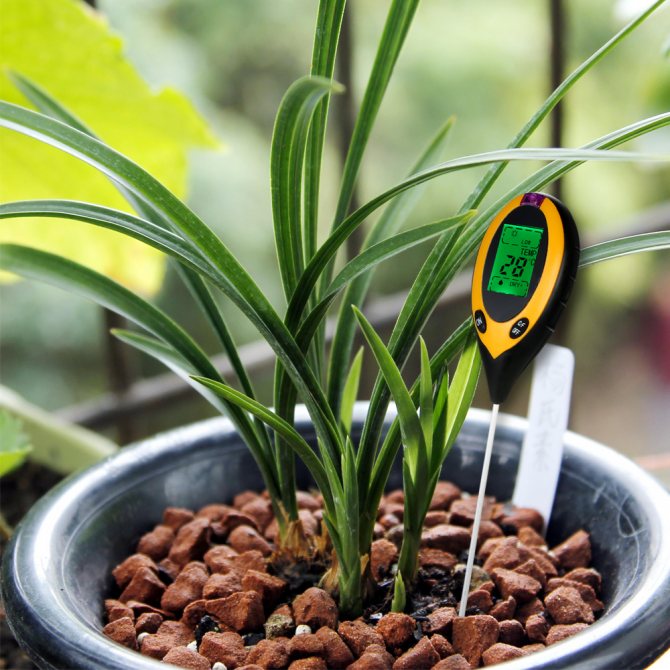

Soil moisture indicator
To care for indoor flowers, it is necessary to feed them in a timely manner, take care of the level of lighting, temperature and humidity. However, without proper regular watering, nothing will work. It is worth taking care of this even at a time when the whole family is leaving somewhere, and there is no one to water the flowers. For such situations, a special device sold in stores and providing them with automatic watering is suitable. It is worth providing the flowers with the necessary care, and they will delight with their chic appearance and bright lush flowering.
No watering for everyone at once!
Allocating a specific day / days of the week for watering and watering all plants indiscriminately at the same time is the biggest mistake. This is certainly more convenient. But indoor plants are all different, and it is also worth watering them at different times.
Indoor plants can be grouped according to the degree of moisture-loving (moisture-loving, moderately moisture-loving or drought-resistant) and even by origin (desert, subtropical, tropical). But it's better to check the individual variety and species recommendations and make a schedule for each plant.
A good strategy is to keep simple records or tables, or use tags and labels on pots with information about:
- how often and abundantly you need to water the plant at different stages of development;
- how much water can be left in the pallets;
- what should be the water.
Always highlight plants with special "markers" that are watered through trays, using the wick method, pouring water into the funnels of leaves, or by dipping.
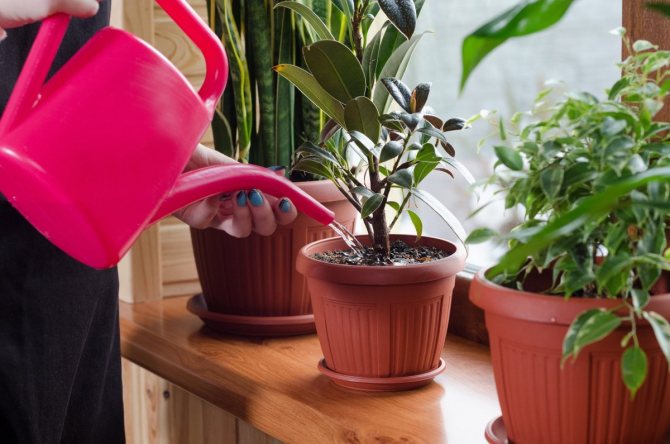

Indoor plants can be grouped according to the degree of moisture-loving (moisture-loving, moderately moisture-loving, or drought-resistant). <>
The importance of water in plant life
Watering is vital for indoor flowers. With a lack of water, nutrients from the soil do not dissolve and the plants wither and experience hunger. Without water, the process of photosynthesis is inhibited, organic compounds are not formed, which leads to death. With an excess of water, the permeability of the soil decreases, the root system begins to suffocate and often rots, which will also lead to death. Therefore, it is necessary to select light soil with good air permeability and fertile. Usually the ground is mixed with sand, peat, compost. In addition, water acts as a temperature regulator, evaporating from the surface of the foliage. In order not to chill the plants, watering is carried out with warm water.
5 watering while on vacation
Sometimes you have to leave home for a while, and of course, you should make sure that the plants do not suffer from lack of attention and lack of watering. The best way out in such a situation will be the help of neighbors, but if there is no one to look after the plants, then you should pay attention to the irrigation systems. Some irrigation systems can be purchased at flower shops, others are easy to assemble by yourself.
Before the detour, you should remove the plants from the windowsills and remove them from the balcony. The color should be moved to the room, placing them in a fairly close space, on the floor, behind the curtain. This location excludes the sun's rays, which accelerate the evaporation of moisture. Of course, plants should stand away from heating appliances.
Consider various irrigation options and structures that prevent rapid evaporation of moisture during the absence.
5.1. Boy
A transparent plastic bag can be built over each flower. Naturally, only those flowers that can be at high humidity for a long period of time can be placed under such a shelter. In order for the package not to touch the sheet plates anywhere, wooden skewers are preliminarily forged into the pot. The fact is that rot may appear in the places of contact with the film. Also, instead of polyethylene, you can use transparent plastic caps. If the flower cannot withstand prolonged exposure to a humid atmosphere, then it is worth covering the substrate in the pot with a film - this will also help prevent rapid evaporation of moisture.
5.2 Dropper and watering from a bottle
A bucket of water is placed on a dais and the upper part of the dropper is placed in it. Plant pots are placed in the immediate vicinity of the bucket. The drip tip is inserted into the soil and the frequency of the drops is adjusted.
Watering from a bottle works in a similar way - a plastic bottle is filled with water, closed with a lid. A small hole is made in the lid through which water will flow. The bottle upside down is inserted into the potted substrate.
In flower shops, you can find decorative clay cones specially designed for auto-irrigation, which have small irrigation holes on the top. The cone is filled with water and inserted into the soil in a pot.
5.3 Hygroscopic wicks
To create such a wick, you can use a regular medical bandage, twisted with a tourniquet. The bandage is pulled with a needle and thread into the drainage holes and through the entire soil to the soil surface. A container with water is placed under the flower pot or next to the plant and the end of the wick is lowered into it. When using this method, you can adjust the amount of moisture introduced using the thickness of the bundle - the thicker it is, the more abundant the watering will be.
Now in flower shops they sell pots specially designed for this method of watering with a large tray for water at the base.
5.4 Capillary mat
Currently, in flower shops you can find special capillary mats - pieces of artificial felt with a backing. To use the mat, take a balcony flower box without drainage holes and put a mat on its bottom, which is then soaked in water for irrigation. Pots of flowers are placed on top. With this method of watering, you should pay attention to the fact that the drainage holes in the pots should be at the very bottom and the soil should have direct contact with the mat in order to absorb the required amount of moisture.
You can also spread a similar mat on the sink - in the part where clean dishes are usually located. Plug the drain hole of the sink and fill it with water. Place the end of a hygroscopic wick in the water, which can be made from a bandage. Place the other end of the wick on the mat and place flower pots on it.
Instead of a capillary mat, you can use an ordinary newspaper folded in several layers, thoroughly moistened with water.
5.5. Automatic irrigation system
In stores, you can find specially designed devices for autowatering - both ordinary drip hoses and serious devices equipped with timers. With the help of such a system, connected to the mains and water supply, it is possible to organize watering of a large number of plants. The proportion of water that goes into a particular pot can also be adjusted.
Ways to automatically water flowers
Flowers that love water, in their long absence, can be moistened with automatic irrigation. For this, methods are used that will answer the question of how to water flowers while on vacation:
- wick;
- plastic bottles;
- pallet with expanded clay;
- plastic bags;
- medical droppers;
- hydrogel;
- mats;
- automatic pots;
- flasks for humidification;
- ready-made automatic irrigation systems.
Any of these methods must first be tested. This will help you find the right amount of water for your blooming pet to grow well. Also carefully study all the pros and methods of each method. For example, the plastic bag greenhouse method with water can lead to mold and mildew, and the hydrogel requires a complete transplant. The best way would be a ready-made car system, but it's expensive.
Irrigation water
Many flower growers have a question: what kind of water to water indoor flowers?
Distilled water is the most suitable water for irrigation. There are no salt impurities or chlorine in it. You can prepare distilled water with a deionizer or purchase it at a pharmacy kiosk. But there are no minerals in it. The situation is just right to correct with the help of ordinary settled water, pouring it into distilled water. You can enrich it with useful substances by adding special fertilizers.
Rainwater is oxygen-rich and neutral. But due to poor ecology, various chemicals, soot and so on get into it. Collecting the most useful water is possible if you follow these tips:
- At the time of heavy rain, it is necessary to collect water half an hour after it began.
- It should not be harvested after a long drought.
Activated carbon can remove chlorine and fluorine from water, while calcium and heavy metal salts will be retained in it, and it will be possible to get rid of them with the help of filters.
Plants also respond well to melt water. It can be made both independently in summer and in winter from snow. But there are conditions:
- It is advisable to collect snow outside the metropolis, since there it is much cleaner than urban. After all, soot, dust, soot and so on are not deposited on it.
- If it is not possible to leave the city, collect snow, paying attention to its color and smell. If the resulting water has an unpleasant odor and cloudy color, discard it.Flowers should not be watered with such water.
- It is advisable to collect freshly fallen snow, there is a minimum amount of dust on it.
But where to get melted water in summer? The refrigerator will help with this. We put a small container in the freezer. We are waiting for two-thirds of its volume to turn into ice. We drain the remaining moisture. We pull out the container and wait for the ice to melt.
Watering should be done only when needed
Checking the degree of drying of the substrate and controlling the rate of moisture consumption by the plant at different stages of development will allow avoiding gross errors with watering. Whatever the standard recommendations, you need to judge the need for watering only by the soil.
Before taking up the watering can, it is worth checking if the plant needs watering:
- Check the moisture content of the upper layer of the substrate (superficially and at a depth of 1 to 2 cm, lightly rubbing the ground between the fingers;
- Compare whether the pot has become lighter (the weight of the pot before and after watering is significantly different).
2.Types of plants
According to the need for moisture, the following types of plants are distinguished.
Hydrophytes - Plants growing in swampy areas directly in the water or on its surface.
Hygrophytes - preferring boggy soil - such species are able to quickly evaporate moisture through the leaves and cannot stand even the slightest drying out. They have a small root system, as there is no need to extract water deep underground.
Mesophytes - plants that consume an average volume of water - the vast majority of indoor flowers belong to this type.
Xerophytes - plants of deserts, semi-deserts and steppes. The main distinguishing feature is the leaves - they are often small in size and have a surface that prevents moisture evaporation as much as possible - for example, pubescent. They have a highly developed root system.
Succulents the main difference between these plants is the presence of moisture-storing organs - it can be retained in fleshy leaves, a powerful root system or directly in the stem - caudex.
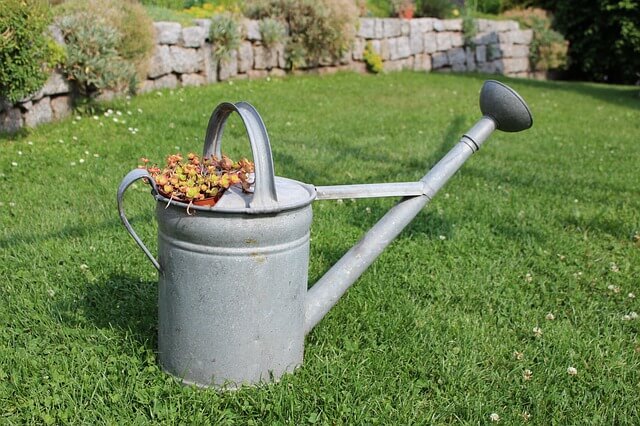

Cacti and succulents need a special irrigation regime - the soil should dry out by a third or even half between waterings. If a cool dormant period is necessary, watering practically stops and simply protects the earthen lump from completely drying out. Watering is carried out carefully - right under the root, preventing moisture from entering the plant itself.
Orchids, contrary to popular belief, they rather need high humidity than excessive watering. Block orchids should be watered frequently.
Ferns often grow in wetlands and tolerate abundant watering well, but suffer when even a slight drought occurs.
Ampel plantsplanters grown in hanging pots are likely to have to be watered more often; those grown on a windowsill.
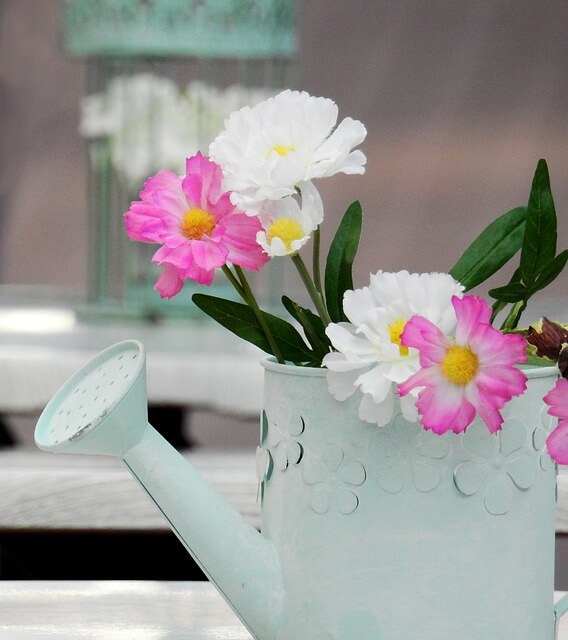

Improper watering and its consequences
In fact, the very amount of moisture (its excess and insufficiency) does not harm the plants so much. The wrong amount leads to a negative effect on the soil - an increase in oxidation or alkalinity. So, for example, a cactus disappears not from a large amount of water, but from the high acidity of the soil, which the same water creates.
Also, when the soil is excessively moistened, water closes all the pores in it, from which most of the root hairs stop breathing and die. And because of its lack, the root system cannot absorb moisture, which is why the flowers and foliage dry out and wither.
Signs of improper watering
Lack of moisture:
- Leaves are soft, drooping.
- The ground is dry as fluff.
- Flowers and buds wither and fall quickly.
- Hard leaves dry up and fall off, while soft leaves fall and become lethargic.
Excess moisture:
- Slowdown in growth.
- The presence of soft areas on the deciduous canopy with signs of rot.
- Permanently damp ground.
- The presence of mold on the surface of the earthen coma.
- Both old and new leaves fall.
- Faded and yellowed leaves.
- Deciduous cover with brown tips.
Adhering to the golden rule: watering indoor flowers is better done more often, but in moderation, than rarely, but abundantly, you can avoid the most gross mistakes.
8 fix bugs
If, through an oversight, the earthen lump has dried up, you can place the pot with the plant in a large container with warm water and leave it there for 1 - 2 hours until it is completely saturated with moisture. After this procedure, the plant is taken out and placed on a pallet, where excess moisture flows - after a few minutes this excess is drained.
The flooded plants are removed from the ground and dried with paper towels or simply in the air. Rotten roots are cut to healthy areas, and the cuts are sprinkled with crushed charcoal. Flowers treated in this way are planted exclusively in fresh soil, since rot pathogens may remain in the old one.
How to soften water for plants
You can soften hard water by boiling it. Thus, harmful substances will precipitate and turn into scale. The water should be allowed to cool down for a while, and only then the plants should be watered. Its temperature should be at room temperature or 4-5 degrees higher.
You can soften the water with lemon juice or its acid. You can use table vinegar or apple cider vinegar to make it less harsh. To do this, add 10 drops of vinegar to 1 liter of water. A lime neutralizer for water is sold in specialized stores.
It is also possible to acidify the water with the help of high-moor peat. It must be put in a plastic bag with small holes, and then dipped into the water prepared for irrigation. One liter is enough for 100 grams of peat.

